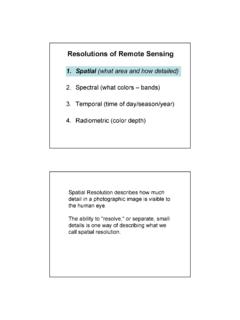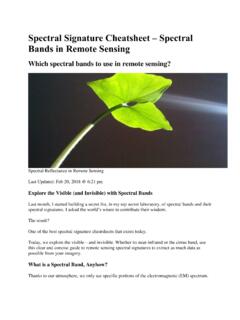Transcription of Active and Passive Remote Sensing - University of Rhode …
1 Active and Passive Remote Sensing Passive Remote Sensing systems record EMR. that is reflected ( , blue, green, red, and near-infrared light) or emitted ( , thermal infrared energy) from the surface of the Earth. Active Remote Sensing systems are not dependent on the Sun's EMR or the thermal properties of the Earth. Active Remote sensors create their own electromagnetic energy that is transmitted from the sensor toward the terrain interacts with the terrain producing a backscatter of energy is recorded by the Remote sensor's receiver. The most widely used Active Remote Sensing systems include: Active microwave (RADAR= RAdio Detection and Ranging), which is based on the transmission of long-wavelength microwave ( , 3-25 cm) through the atmosphere and then recording the amount of energy backscattered from the terrain. The beginning of the RADAR technology was using radio waves. Although radar systems now use microwave wavelength energy almost exclusively instead of radio wave, the acronym was never changed.
2 1. LIDAR (LIght Detection And Ranging), which is based on the transmission of relatively short- wavelength laser light ( , m) and then recording the amount of light backscattered from the terrain;. SONAR (SOund NAvigation Ranging), which is based on the transmission of sound waves through a water column and then recording the amount of energy backscattered from the bottom or from objects within the water column. RADAR. The ranging capability is achieved by measuring the time delay from the time a signal is transmitted to the terrain until its echo is received. Because the sensor transmitted a signal of known wavelength, it is possible to compare the received signal with the transmitted signal. From such comparisons imaging radar detects changes in frequency that form the basis of capabilities not possible with other sensors. 2. Sending and Receiving a Pulse of Microwave EMR - System Components 3.
3 Brief History of RADAR. 1922, Taylor and Young tested radio transmission cross the Anacostia River near Washington 1935, Young and Taylor combined the antenna transmitter and receiver in the same instrument. Late 1936, Experimental RADAR were working in the , Great Britain, Germany, and the Soviet Union. 1940, Plane-The circularly scanning Doppler radar (that we watch everyday during TV weather updates to identify the geographic locations of storms). 1950s, Military began using side-looking airborne radar (SLAR or SLR). 1960s, synthetic aperture radar (SAR). 1970s and 1980s, NASA has launched two successful SARs, SEASAT, Shuttle-Imaging Radar (SIR). 1990s, RADARSAT . 4. Active Microwave (RADAR) Commonly Use Frequencies Band Designations (common wavelengths Wavelength ( ) Frequency ( ). shown in parentheses) in cm in GHz _____. K - to Ka ( cm) - to Ku - to X ( and cm) - - C ( , cm) - - S ( , , cm) - - L ( , , cm) - - P ( cm) - 100 - 5.
4 Airborne Side-Looking Radar (SLAR or SLR). Radar Nomenclature Nadir azimuth flight direction range (near and far). depression angle ( ). look angles ( ). incidence angle ( ). altitude above- above-ground- ground- level, H. polarization 6. Azimuth Direction The aircraft travels in a straight line that is called the azimuth flight direction. direction. Pulses of Active microwave electromagnetic energy illuminate strips of the terrain at right angles (orthogonal) to the aircraft'. aircraft's direction of travel, which is called the range or look direction. direction. The terrain illuminated nearest the aircraft in the line of sight is called the near- near-range. range. The farthest point of terrain illuminated by the pulse of energy is called the far- far-range. range. Look Direction The range or look direction for any radar image is the direction of the radar illumination that is at right angles to the direction the aircraft or spacecraft is traveling.
5 Generally, objects that trend (or a. X - band, HH polarization look direction strike) in a direction that is perpendicular to the look direction are enhanced much more than those objects in the terrain that lie parallel to the look direction. Consequently, linear features that appear dark in a radar image using one look direction may appear bright in another radar image with a different look direction. b. s X - band, HH polarization look direction 7. Depression Angle The depression angle ( ) is the angle between a horizontal plane extending out from the aircraft fuselage and the electromagnetic pulse of energy from the antenna to a specific point on the ground. The depression angle within a strip of illuminated terrain varies from the near- near-range depression angle to the far- far-range depression angle. The average depression angle of a radar image is computed by selecting a point midway between the near and far- far-range in the image strip.
6 Summaries of radar systems often only report the average depression angle. Incident Angle The incident angle ( ) is the angle between the radar pulse of EMR and a line perpendicular to the Earth'. Earth's surface where it makes contact. When the terrain is flat, the incident angle ( ) is the complement ( ( = 90. - ) of the depression angle ( ). If the terrain is sloped, there is no relationship between depression angle and incident angle. The incident angle best describes the relationship between the radar beam and surface slope. Many mathematical radar studies assume the terrain surface is flat (horizontal) therefore, the incident angle is assumed to be the complement of the depression angle. 8. RADAR Resolution To determine the spatial resolution at any point in a radar image, it is necessary to compute the resolution in two dimensions: the range and azimuth resolutions. Radar is in effect a ranging device that measures the distance to to objects in the terrain by means of sending out and receiving pulses of Active microwave energy.)
7 The range resolution in the across- across-track direction is proportional to the length of the microwave pulse. The shorter the pulse length, the finer the range resolution. Azimuth resolution (Ra) Ra) is determined by computing the width of the terrain strip that is illuminated by the radar beam. beam. 9. Azimuth resolution (Ra) Ra) is determined by computing the width of the terrain strip that is illuminated by the radar beam. beam. The beam width is inversely proportional to antenna length (L). Where S is the slant-range distance to the point of interest. This means that the longer the radar antenna, the narrower the beam width and the higher the azimuth resolution. Synthetic Aperture Radar (SAR). A major advance in radar Remote Sensing has been the improvement in azimuth resolution through the development of synthetic aperture radar (SAR) systems. Great improvement in azimuth resolution could be realized if a longer antenna were used.
8 10. Synthetic Aperture Radar (SAR). Engineers have developed procedures to synthesize a very long antenna electronically. A SAR uses a relatively small antenna ( , ( , 1 m) that sends out a relatively broad beam perpendicular to the aircraft. A greater number of additional beams are sent toward the the object. Doppler principles are then used to monitor the returns from all these additional microwave pulses to synthesize the azimuth resolution to become one very narrow beam. beam. Radar Measurements 11. Radar Measurements Expected surface roughness back- scatter from terrain illuminated with 3 cm wavelength microwave energy with a depression angle of 45 . 12. Wavelength and Penetration of Canopy The longer the microwave wavelength, the greater the penetration of vegetation canopy. Wavelength and Penetration of Canopy The longer the microwave wavelength, the greater the penetration of vegetation canopy.)
9 13. Polarization Unpolarized energy vibrates in all possible directions perpendicular to the direction of travel. The transmitted pulse of electromagnetic energy interacts with the terrain and some of it is back-scattered at the speed of light toward the aircraft or spacecraft where it once again must pass through a filter. If the antenna accepts the back- scattered energy, it is recorded. Various types of back- scattered polarized energy may be recorded by the radar. Polarization Radar antennas send and receive polarized energy. This means that the pulse of energy is filtered so that its electrical wave vibrations are only in a single plane that is perpendicular to the direction of travel. The pulse of electromagnetic energy sent out by the antenna may be vertically or horizontally polarized. 14. Polarization It is possible to: Send vertically polarized energy and receive only vertically polarized energy (designated VV).
10 VV). Send horizontal and receive horizontally polarized energy (HH. (HH)). Send horizontal and receive vertically polarized energy (HV. (HV)). Send vertical and receive horizontally polarized energy (VH. (VH)). HH and VV configurations produce like- like-polarized radar imagery. HV and VH configurations produce cross- cross-polarized imagery. 15. An example of radar penetration of dry soil along the Nile River, Sudan. The Space-borne Imaging Radar (SIR) polarized data reveal an ancient, previously unknown channel of the Nile. Space Shuttle Color-Infrared Photograph SIR-C Color Composite: Red = C-band HV. Green = L-band HV. Blue = L-band HH. 16. SIR-C/X-SAR Images of a Portion of Rondonia, Brazil, Obtained on April 10, 1994. Geometric Relationship Between Two SAR Systems Used for Interferometry to Extract Topographic Information: InSAR. 17. Shuttle Radar Topography Mission (SRTM). Electrical Characteristics and Relationship with moisture One measure of a material's electrical characteristics is the complex dielectric constant, defined as a measure of the ability of a material (vegetation, soil , rock, water, ice) to conduct electrical energy.




